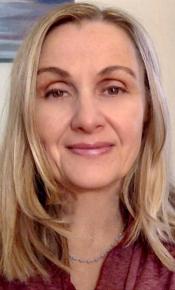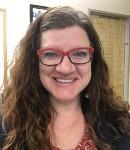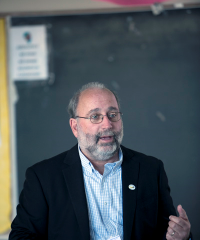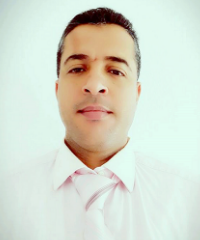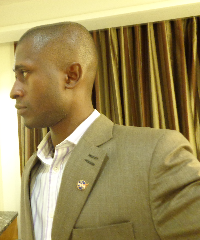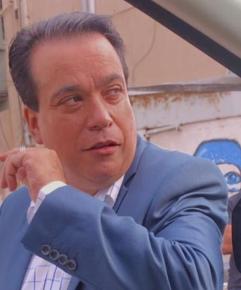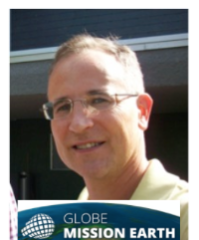Community Blogs
Community Blogs
Discover how the GLOBE community is engaging in all things GLOBE through the community blog posts below.
Learn how to create a GLOBE community blog post.
Filter By:
Blogs List
Yesterday, I visited Bell Multicultural High School and Lincoln Middle School, which share a campus near my home. It was inspiring, and I saw good science teaching with students doing research experiments dealing with bioremediation of soils. In discussions, I found myself talking about GLOBE and the many aspects of what the Program offers.
Students were experimenting with plant uptake of soil contaminants and were planning to take water samples from the Anacostia River bordering the area where they had collected soil samples. Their insight into the soil could be greatly expanded ...
Read More »
Posted in:
A heat lamp and reflector socket with a spring clamp may be purchased on-line for as little as $26. The amount of time required to dry samples depends on many things including the wetness of the initial sample, the soil characteristics, the relative humidity, and the temperature to which the sample is heated. GLOBE protocols specify that samples are not to be heated above 105 o C. In using a heat lamp, the temperature to which the sample is heated depends on the wattage of the bulb and the distance between the heat lamp and the sample bag.
I have tried drying a sample using this ...
Posted in:
Phenology: Community Storytelling in Action
(This is a continuation of my blog about Rising Voices. Click here to see the first blog entry in this series.)
"How healthy is our reef?"
The following day, after meeting Aunty Pua Case and hearing about the sacredness of Mauna Kea and touring the Mauna Loa Observatory, we went to the Ka’upulehu Interpretive Center to learn about place-based learning in Hawai’i. There, we met Aunty Lei - another powerful educator and leader who talked about the educational center that they created in their community and some of the ...
Posted in:
Blog Two
(This is a continuation of my blog about Rising Voices. Click here to see the first blog entry in this series.)
Part One: Mauna Kea
“Let’s do something that is right for our mountain, and our people, and our mountain.”
Location: Pu’uhuluhul, base of the Mauna Kea Mountain, en route to Mauna Loa Observatory
We arrived at the base between two mountains: Mauna Kea and Mauna Loa. We met Aunty Pua Case, who shared the importance of Mauna Kea to the people of Hawai’i and led us through a cultural protocol to recognize the sacredness of the space. Similar to ...
Posted in:
Blog One: Rising Voices: Collaborative Science with Indigenous Knowledge for Climate Solutions
Credit: Craig Elevitch
Nana ka maka, look with your eyes.
Ho'olohe ka pepeiao, hear with your ears (not your Heart).
Paa ka waha, shut your mouth.
Hana i ka lima, work with your hands.
According to the United States National Climate Assessment 2014 , “c limate change threatens Native Peoples’ access to traditional foods and adequate water. Alaskan Native communities are increasingly ...
Posted in:
GLOBE friends,
The Annual Meeting in Colorado is only a few days away! We -the members of the Evaluation Working Group- are really excited about having the opportunity to meet in person again and about having the chance to interact with all of you.
Join us for our presentations to see what we have worked on for the past year. Our efforts will be much more targeted and much more effective if you share with us your experience of using GLOBE with your students. We would like to know your success stories, your challenges, your concerns and your suggestions.
At ...
Posted in:
GLOBE Working Groups:
EVALUATION WORKING GROUP
Bird Beaks and What they Eat
Overview:
Students identify ideal beak shape for food.
Age:
Upper primary (4th and 5th graders) assisted 1st graders
Materials:
Bird beak/food handout
Straws
Dixie cups
Juice
Tweezers
Bowls
Wild grain rice
Slotted spoons
Cooked noodles (macaroni or similarly shaped)
Chopsticks
Gummy bears
White rice
Scissors
Marshmallows (jumbo)
Plan:
Ask students why birds have beaks and what they are used for - allow time for discussion. Read a book about beaks to the group. I used ...
Posted in:
Curriculum:
SCIENCE AND MATH
GLOBE Science Topics:
GENERAL SCIENCE
Learning Activities:
LAND COVER/BIOLOGY
Primary Audience:
TEACHERS
STUDENTS
Click on the link forwarded by Dr.Tim Schmit (GOES-R PI) to view some amazing imagery!
http://cimss.ssec.wisc.edu/ goes/blog/archives/category/goes-14
Posted in:
Looking for collaborators on the GOES-R Weather Watchers Project. Let's bring the satellite and STEM education community together!
Posted in:
This is the second half to a blog posted on 25 March 2016. To see part one, click here . We are pleased that our guest blogger, Jacob Spivey, is back to share more information about oceans and climate. Jacob also blogs at Weatherbolt .
If part of the ocean has a lower salinity, then it’s going to be less dense and there won’t be as much sinking water there. This can trigger the slowdown of another circulation, the Atlantic Meridional Overturning Circulation, or AMOC (thank goodness scientists abbreviate some of the names that they come up with!). Like the GTC, this is another ...
Posted in:
We are pleased to welcome guest blogger Jacob Spivey. Jacob is a senior undergraduate in Meteorology with a minor in Climatology at Penn State University. Fascinated by weather extremes as he was growing up, today he looks at possible relationships between extreme weather and climate change. Within the past few years, he has also begun looking at how these subjects are communicated to the general public, a process which he has started doing himself in his online blog, Weatherbolt .
Ask someone what they think of when they hear about climate change, and you might get a ...
Posted in:
See https://www.facebook.com/groups/602168936587444/
Posted in:
The next GLOBE training will occur at the University of North Dakota on Monday 8 August and Tuesday 9 August 2016, with online components beginning Friday 5 August.
Trainers will be Dr. Laura Munski of the Dakota Science Center and Dr. Matt Gilmore of Atmospheric Sciences.
New this year, teachers will watch several introductory online videos and complete several hours of e-training with quiz questions - totaling 3 hours of online instruction.
Invited again this year are pre-service teachers (e.g., students at UND or Mayville State ...
Posted in:
Why should we study mosquitos in our area?
By Mullica Jaroensutasinee, Krisanadej Jaroensutasinee, Walailak University
Rebecca Boger, Brooklyn College and Elena Sparrow, UAF
Before we try to answer this, we should ask ourselves about how much do we know about them? For example, how many mosquito species present in our area? Would they carry some diseases? Where are their main breeding sites? Would they prefer to bite kids than adults and elderly? What time of year? What time of day would they most active (biting us)?
Let us give you some example on mosquitos that ...
Posted in:
GLOBE Working Groups:
SCIENCE WORKING GROUP
Thai Coral Reef and Climate Change
Assoc. Prof. Krisanadej Jaroensutasinee, Assoc. Prof. Dr. Mullica Jaroensutasinee, Centre of Excellence for Ecoinformatics, Walailak University, Thailand
Everybody loves to spend their vacation snorkling or diving, seeing coral reef, reef fish and other marine creature. Would it be very sad when we go diving and see lots of dead corals? Of course, we would. What can we do to prevent this to happen? How can we and our students involve in some coral conservation? It is everyone responsibility to help improve our world to be a better place to live ...
Posted in:
GLOBE Working Groups:
SCIENCE WORKING GROUP
look for a colleague from university of India (nanomaterials) to collaborate with him
Posted in:
My first empirical contact with the soil started almost 10 years ago when I was writing my B.Sc Dissertation on Grain Size Characteristics of Overbank Deposit on the Floodplains of Opa Reservoir Basin SW Nigeria . While undergoing this research I took 200 core bulk soil sediments along the three selected floodplains coupled with laboratory testing of samples, after a year the research was published by International Journal of Environmental Hydrology. http://www.hydroweb.com/journal-hydrology-2007-paper-22.html
The SMAP training at LA during the 20th GLOBE Annual and Partners ...
Posted in:
Field Campaigns:
SMAP
GLOBE Working Groups:
SCIENCE WORKING GROUP
MERRY CHRISTMAS
Posted in:
The Surface Temperature Field Campaign has come to a close, but please feel free to keep taking surface temperature observations. I know that many of you and your students are still taking observations and you are planning your projects to present at science fairs as well as the GLOBE regional science fairs.
The Surface Temperature field campaign ran through the first day of winter. In the Northern Hemisphere, the official first day of winter is December 22 this year and in the Southern Hemisphere, it was the first day of summer . The start of the seasons are actually defined in ...
Posted in:
Field Campaigns:
SURFACE TEMPERATURE
GLOBE Working Groups:
SCIENCE WORKING GROUP
This second week of the surface temperature field campaign has seem probably the warmest temperatures that we have seen in any field campaign in the eastern United States. I was at Ida Middle School in Michigan yesterday and the kids were outside in short sleeve shirts. The student was a little cold but it wasn’t terrible. Some years there is 200 mm of snow on the ground.
We have had 26 schools, 8 countries and 9 US states enter 414 observations. Roswell-Kent Middle School is leading the pack with 83 observations. Main Street School in Ohio and Crestwood High School in Michigan are ...
Posted in:
Field Campaigns:
SURFACE TEMPERATURE
GLOBE Working Groups:
SCIENCE WORKING GROUP
—
20 Items per Page








